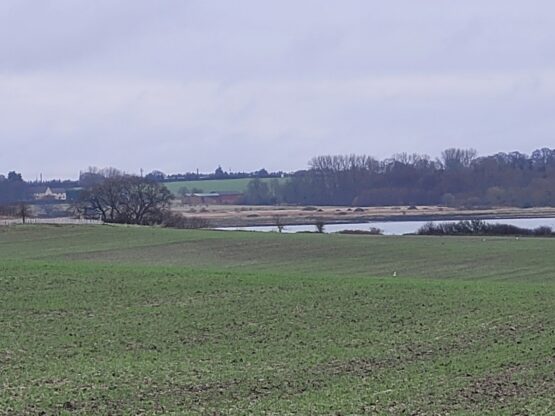Farming in Protected Landscapes Case Study:
Traditional orchard and hedgerows project for East Suffolk Farmer Group

For Years 3 and 4 of the Farming in Protected Landscapes programme, £115,865 was awarded to the East Suffolk Farmer Group to create six new traditional orchards and 3,800 metres of hedgerows with trees in the southern half of the Suffolk & Essex Coast & Heaths National Landscape.
This large-scale project covers 10 farms over 5,300 Hectares on the Shotley, Felixstowe and Orford peninsulas.
Overview
Members of the East Suffolk Farmers group are working collaboratively to establish 3827m of new hedgerows to help strengthen wildlife corridors in the National Landscape. This will give the farmer group the chance to link habitats on a landscape scale.
The project concentrates on establishing new linear habitats to form corridors allowing freer movement of species between farms. Each participant will be contacted by the group advisor to ensure the optimum location of these new habitats.
What is being done to improve the landscape?
Planting six new orchards to follow on from the 16 planted in years 1 and 2 of the Farming in Protected Landscapes programme, which are now flourishing and in blossom.
The project funded the purchase and installation of deer fencing of five of the new orchards to protect the young trees (and associated naturally regenerated vegetation) from deer browsing. The area has substantial populations of muntjac, together with large numbers of roe, red and Chinese water deer, so this fencing is absolutely vital to protect the young trees.
Specialist advice was provided to select heritage fruit/nut tree varieties and cultivars which are suitable to not only the National Landscape area, but to each individual orchard location.
The farmers ensured that each species is historically and culturally correct on a site by site basis, also taking into account soil type, site aspect and environmental conditions. This project will help to prevent loss of these old varieties.
Each orchard will be managed and maintained by its respective landowner, who will maintain them in perpetuity, for maximum biodiversity and landscape value. The orchards will provide no commercial benefit for any of the participants in this project.
New hedgerows were strategically positioned in such a way as to connect existing habitat or to complement other new habitat creation projects, complement existing landscape features or aspect or for historical completeness.
The long new hedge stretches inland from the River Orwell to connect with a wood and hedgerows along the way. The hedgerows are planted with a range of native trees.


How will the land be managed in the future?
Both the new hedges and the new orchards will help to generate improvements in terms of both carbon sequestration, diffuse pollution reduction and biodiversity. In the orchards, the grass between the trees will only be cut once a year or so, allowing natural regeneration of wild flowers. The orchards will support many species as it matures.
Hedgerow management will include adopting best practice as regards hedgerow bottom management and using sympathetic trimming when the hedges are mature. In addition to these direct biodiversity benefits, the establishment of new orchards and hedgerows will support an improvement in landscape climate change resilience. This will be achieved through soil improvements (particularly noticeable where the new orchards will see a change in land use from intensive arable and vegetable production).
New tree planting will provide summer shade and shelter throughout the year, and help to improve infiltration and reduce runoff of rainfall, while also improving soil structure which will have further soil-moisture benefits for other organisms, as environmental conditions continue to change.
The increased hedgerow network will enable species to move freely, especially important as the climate changes.
This area holds many intensively farmed businesses that are adjacent to some of the most important and vulnerable habitats. A large project like this enables the farm cluster to work on a landscape scale provides synergistic benefits to help protect these.
